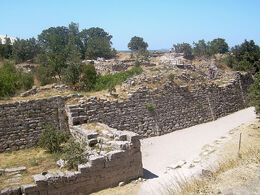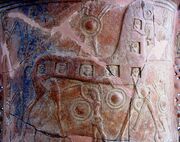
| |
|---|---|
| Troy | |
| Name | Troy |
| Debut | Retribution |
| Significance | Trojan Spaceport |
| Photo | The walls of the acropolis of Troy on Earth[1] |
Troy (Greek Troia, also called Ilios or Ilion, Latin Troia, Troja, or Ilium) is an ancient city in northwestern Anatolia that holds an enduring place in both literature and archaeology.
Overview[]
The legend of the Trojan War is the most notable theme from Ancient Greek literature and forms the basis of Homer’s Iliad. Although the actual nature and size of the historical settlement remain matters of scholarly debate, the ruins of Troy at Hisarlik, Turkey, are a key archaeological site whose many layers illustrate the gradual development of civilization in northwestern Asia Minor.[2]
Historical Site[]
Inhabited from the Early Bronze Age (3000 BCE) through to the Twelfth century CE, the archaeological site, which is now called Troy, is five kilometers from the coast, but was once next to the sea. The site was situated in a bay created by the mouth of the river Skamanda and occupied a strategically important position between Aegean and Eastern civilizations by controlling the principal point of access to the Black Sea, Anatolia and the Balkans from both directions, by land and sea. In particular, the difficulty in finding favourable winds to enter the Dardanelles may well have resulted in ancient sailing vessels standing by near Troy. Consequently, the site became the most important Bronze Age city in the North Aegean, reaching the height of its prosperity in the middle Bronze Age, contemporary with the Mycenaean civilization on the Greek mainland and the Hittite empire to the East. Excavations. . . have revealed nine different cities and no less than forty-six levels of inhabitation at the site. These have been labelled Troy I to Troy IX.[3]
Ancient Greek Religion[]

In the Iliad, Homer describes Troy as ‘well-founded’, ‘strong-built’ and ‘well-walled’. There are also several references to fine battlements, towers, and ‘high’ and ‘steep’ walls. The walls must have been unusually strong in order to withstand a ten-year siege and in fact, Troy fell through the trickery of the Trojan horse ruse rather than any defensive failing.
Indeed. . . the walls were so impressive that they were said to have been built by Poseidon and Apollo who, after an act of impiety, were compelled by Zeus to serve the Trojan king Laomedon for one year. However, the fortifications did not help the king when Herakles sacked the city with an expedition of only six ships. The sacking was Herakles’ revenge for not being paid for his services to the king when he killed the sea-serpent sent by Poseidon. This episode was traditionally placed one generation before the Trojan War as the only male survivor was Laomedon’s youngest son Priam, the Trojan king in the later conflict.[5]
Examples[]
- Trojan Spaceport
- The planet Troy, which is in the first orbit of the Helios Beta star system.[6]
See Also[]
References[]
- ↑ Photo: The walls of the acropolis belong to Troy VII, which is identified as the site of the Trojan War (circa 1200 BC). Photo by CherryX • CC BY-SA 3.0.
- ↑ Troy at the Encyclopædia Britannica. Retrieved on October 19, 2017.
- ↑ Troy at the Ancient History Encyclopedia. Retrieved on June 12, 2019, edited.
- ↑ Photo: Mykonos vase (670 BCE). Decorated pithos found at Mykonos, Greece, depicting one of the earliest known renditions of the Trojan Horse. Archaeological Museum of Mykonos, Inv. 2240. Photo by Travelling Runes • CC BY-SA 2.0.
- ↑ Troy at the Ancient History Encyclopedia, Ibid.
- ↑ Mandel, Geoffrey. "The Twelve Colonies of Kobol" map. Technical Advisors Jane Espenson and Kevin R. Grazier, special thanks to Bob Harris, author of "Beyond Caprica: A Visitors Guide to the Twelve Colonies", Quantum Mechanix, 2010.
